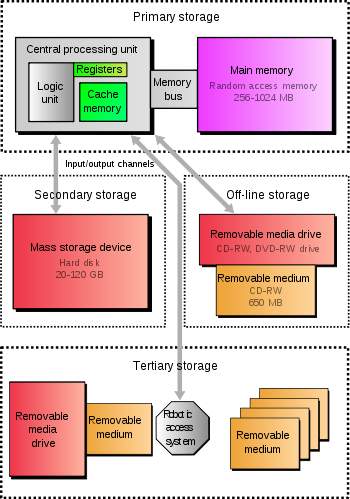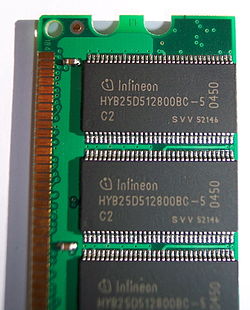Many different forms of storage, based on various natural phenomena, have been invented. So far, no practical universal storage medium exists, and all forms of storage have some drawbacks. Therefore a computer system usually contains several kinds of storage, each with an individual purpose.
A digital computer represents data using the binary numeral system. Text, numbers, pictures, audio, and nearly any other form of information can be converted into a string of bits, or binary digits, each of which has a value of 1 or 0. The most common unit of storage is the byte, equal to 8 bits. A piece of information can be handled by any computer whose storage space is large enough to accommodate the binary representation of the piece of information, or simply data. For example, using eight million bits, or about one megabyte, a typical computer could store a short novel.
Traditionally the most important part of every computer is the central processing unit (CPU, or simply a processor), because it actually operates on data, performs any calculations, and controls all the other components.
Without a significant amount of memory, a computer would merely be able to perform fixed operations and immediately output the result. It would have to be reconfigured to change its behavior. This is acceptable for devices such as desk calculators or simple digital signal processors. Von Neumann machines differ in that they have a memory in which they store their operating instructions and data. Such computers are more versatile in that they do not need to have their hardware reconfigured for each new program, but can simply be reprogrammed with new in-memory instructions; they also tend to be simpler to design, in that a relatively simple processor may keep state between successive computations to build up complex procedural results. Most modern computers are von Neumann machines.
In practice, almost all computers use a variety of memory types, organized in a storage hierarchy around the CPU, as a tradeoff between performance and cost. Generally, the lower a storage is in the hierarchy, the lesser its bandwidth and the greater its access latency is from the CPU. This traditional division of storage to primary, secondary, tertiary and off-line storage is also guided by cost per bit.
Hierarchy of storage

Various forms of storage, divided according to their distance from the central processing unit. The fundamental components of a general-purpose computer are arithmetic and logic unit, control circuitry, storage space, and input/output devices. Technology and capacity as in common home computers around 2005.
Primary storage
- Direct links to this section: Primary storage, Main memory, Internal Memory.
Primary storage (or main memory or internal memory), often referred to simply as memory, is the only one directly accessible to the CPU. The CPU continuously reads instructions stored there and executes them as required. Any data actively operated on is also stored there in uniform manner.
Historically, early computers used delay lines, Williams tubes, or rotating magnetic drums as primary storage. By 1954, those unreliable methods were mostly replaced by magnetic core memory, which was still rather cumbersome. Undoubtedly, a revolution was started with the invention of a transistor, that soon enabled then-unbelievable miniaturization of electronic memory via solid-state silicon chip technology.
This led to a modern random-access memory (RAM). It is small-sized, light, but quite expensive at the same time. (The particular types of RAM used for primary storage are also volatile, i.e. they lose the information when not powered).
As shown in the diagram, traditionally there are two more sub-layers of the primary storage, besides main large-capacity RAM:
- Processor registers are located inside the processor. Each register typically holds a word of data (often 32 or 64 bits). CPU instructions instruct the arithmetic and logic unit to perform various calculations or other operations on this data (or with the help of it). Registers are technically among the fastest of all forms of computer data storage.
- Processor cache is an intermediate stage between ultra-fast registers and much slower main memory. It's introduced solely to increase performance of the computer. Most actively used information in the main memory is just duplicated in the cache memory, which is faster, but of much lesser capacity. On the other hand it is much slower, but much larger than processor registers. Multi-level hierarchical cache setup is also commonly used—primary cache being smallest, fastest and located inside the processor; secondary cache being somewhat larger and slower.
Main memory is directly or indirectly connected to the CPU via a memory bus. It is actually comprised of two buses (not on the diagram): an address bus and a data bus. The CPU firstly sends a number through an address bus, a number called memory address, that indicates the desired location of data. Then it reads or writes the data itself using the data bus. Additionally, a memory management unit (MMU) is a small device between CPU and RAM recalculating the actual memory address, for example to provide an abstraction of virtual memory or other tasks.
As the RAM types used for primary storage are volatile (cleared at start up), a computer containing only such storage would not have a source to read instructions from, in order to start the computer. Hence, non-volatile primary storage containing a small startup program (BIOS) is used to bootstrap the computer, that is, to read a larger program from non-volatile secondary storage to RAM and start to execute it. A non-volatile technology used for this purpose is called ROM, for read-only memory (the terminology may be somewhat confusing as most ROM types are also capable of random access).
Many types of "ROM" are not literally read only, as updates are possible; however it is slow and memory must be erased in large portions before it can be re-written. Some embedded systems run programs directly from ROM (or similar), because such programs are rarely changed. Standard computers do not store non-rudimentary programs in ROM, rather use large capacities of secondary storage, which is non-volatile as well, and not as costly.
Recently, primary storage and secondary storage in some uses refer to what was historically called, respectively, secondary storage and tertiary storage.[1]
Secondary storage

A hard disk drive with protective cover removed.
Secondary storage (or external memory) differs from primary storage in that it is not directly accessible by the CPU. The computer usually uses its input/output channels to access secondary storage and transfers the desired data using intermediate area in primary storage. Secondary storage does not lose the data when the device is powered down—it is non-volatile. Per unit, it is typically also an order of magnitude less expensive than primary storage. Consequently, modern computer systems typically have an order of magnitude more secondary storage than primary storage and data is kept for a longer time there.
In modern computers, hard disk drives are usually used as secondary storage. The time taken to access a given byte of information stored on a hard disk is typically a few thousandths of a second, or milliseconds. By contrast, the time taken to access a given byte of information stored in random access memory is measured in billionths of a second, or nanoseconds. This illustrates the very significant access-time difference which distinguishes solid-state memory from rotating magnetic storage devices: hard disks are typically about a million times slower than memory. Rotating optical storage devices, such as CD and DVD drives, have even longer access times. With disk drives, once the disk read/write head reaches the proper placement and the data of interest rotates under it, subsequent data on the track are very fast to access. As a result, in order to hide the initial seek time and rotational latency, data are transferred to and from disks in large contiguous blocks.
When data reside on disk, block access to hide latency offers a ray of hope in designing efficient external memory algorithms. Sequential or block access on disks is orders of magnitude faster than random access, and many sophisticated paradigms have been developed to design efficient algorithms based upon sequential and block access . Another way to reduce the I/O bottleneck is to use multiple disks in parallel in order to increase the bandwidth between primary and secondary memory.[2]
Some other examples of secondary storage technologies are: flash memory (e.g. USB flash drives or keys), floppy disks, magnetic tape, paper tape, punched cards, standalone RAM disks, and Iomega Zip drives.
The secondary storage is often formatted according to a file system format, which provides the abstraction necessary to organize data into files and directories, providing also additional information (called metadata) describing the owner of a certain file, the access time, the access permissions, and other information.
Most computer operating systems use the concept of virtual memory, allowing utilization of more primary storage capacity than is physically available in the system. As the primary memory fills up, the system moves the least-used chunks (pages) to secondary storage devices (to a swap file or page file), retrieving them later when they are needed. As more of these retrievals from slower secondary storage are necessary, the more the overall system performance is degraded.
Tertiary storage

Large tape library. Tape cartridges placed on shelves in the front, robotic arm moving in the back. Visible height of the library is about 180 cm.
Tertiary storage or tertiary memory,[3] provides a third level of storage. Typically it involves a robotic mechanism which will mount (insert) and dismount removable mass storage media into a storage device according to the system's demands; this data is often copied to secondary storage before use. It is primarily used for archival of rarely accessed information since it is much slower than secondary storage (e.g. 5–60 seconds vs. 1-10 milliseconds). This is primarily useful for extraordinarily large data stores, accessed without human operators. Typical examples include tape libraries and optical jukeboxes.
When a computer needs to read information from the tertiary storage, it will first consult a catalog database to determine which tape or disc contains the information. Next, the computer will instruct a robotic arm to fetch the medium and place it in a drive. When the computer has finished reading the information, the robotic arm will return the medium to its place in the library.
Off-line storage
Off-line storage, also known as disconnected storage, is a computer data storage on a medium or a device that is not under the control of a processing unit.[4] The medium is recorded, usually in a secondary or tertiary storage device, and then physically removed or disconnected. It must be inserted or connected by a human operator before a computer can access it again. Unlike tertiary storage, it cannot be accessed without human interaction.
Off-line storage is used to transfer information, since the detached medium can be easily physically transported. Additionally, in case a disaster, for example a fire, destroys the original data, a medium in a remote location will be probably unaffected, enabling disaster recovery. Off-line storage increases general information security, since it is physically inaccessible from a computer, and data confidentiality or integrity cannot be affected by computer-based attack techniques. Also, if the information stored for archival purposes is accessed seldom or never, off-line storage is less expensive than tertiary storage.
In modern personal computers, most secondary and tertiary storage media are also used for off-line storage. Optical discs and flash memory devices are most popular, and to much lesser extent removable hard disk drives. In enterprise uses, magnetic tape is predominant. Older examples are floppy disks, Zip disks, or punched cards.






